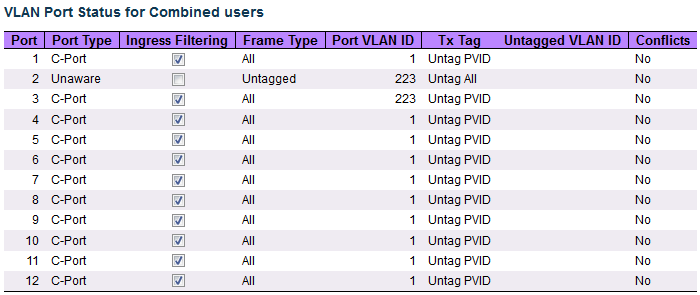VLANs Ports
This page provides VLAN Port Status.

| Object | Description |
|---|---|
| VLAN User | Various internal software modules may use VLAN
services to configure VLAN port configuration on the fly. The drop-down list on the right allows for selecting between showing VLAN memberships as configured by an administrator (Admin) or as configured by one of these internal software modules. The "Combined" entry will show a combination of the administrator and internal software modules configuration, and basically reflects what is actually configured in hardware. If a given software modules hasn't overridden any of the port settings, No data exists for the selected user shows in the table. |
| Port | The logical port for the settings contained in the same row. |
| Port Type | Shows the port type (Unaware, C-Port, S-Port, S-Custom-Port.) that a given user wants to configure on the port. The field is empty if not overridden by the selected user. |
| Ingress Filtering | Shows whether a given user wants ingress filtering enabled or not. The field is empty if not overridden by the selected user. |
| Frame Type | Shows the acceptable frame types (All, Taged, Untagged) that a given user wants to configure on the port. The field is empty if not overridden by the selected user. |
| Port VALN ID | Shows the Port VLAN ID (PVID) that a given user wants the port to have. The field is empty if not overridden by the selected user. |
| Tx Tag | Shows the Tx Tag requirements (Tag All, Tag PVID, Tag UVID, Untag All, Untag PVID, Untag UVID) that a given user has on a port. The field is empty if not overridden by the selected user. |
| Untagged VLAN ID | If Tx Tag is overridden by the selected user and is set to Tag or Untag UVID, then this field will show the VLAN ID the user wants to tag or untag on egress. The field is empty if not overridden by the selected user. |
| Conflicts | Two users may have conflicting requirements to a
port's configuration. For instance, one user may require all frames to be
tagged on egress while another requires all frames to be untagged on egress.
Since both users cannot win, this gives rise to a conflict, which is solved in a prioritized way. The Administrator has the least priority. Other software modules are prioritized according to their position in the drop-down list: The higher in the list, the higher priority. If conflicts exist, it will be displayed as "Yes" for the "Combined" user and the offending software module. The "Combined" user reflects what is actually configured in hardware. |
| Buttons | |
|---|---|
 |
Refresh the page automatically every three seconds. |
 |
Refresh the page immediately. Any non-committed changes will be lost. |
 |
Select VLAN users from this drop-down list. |

